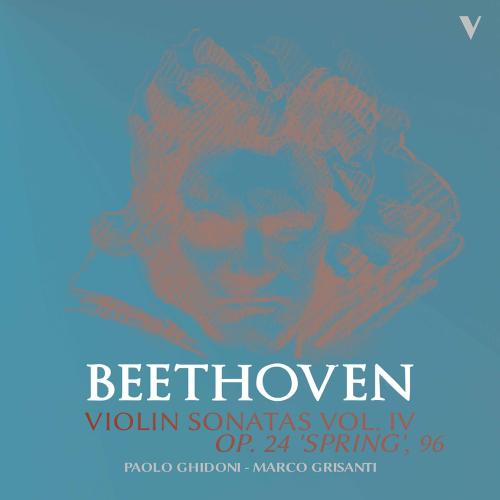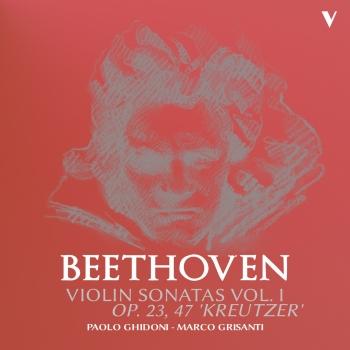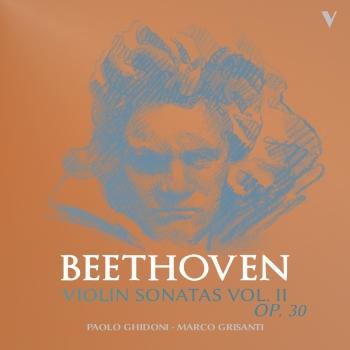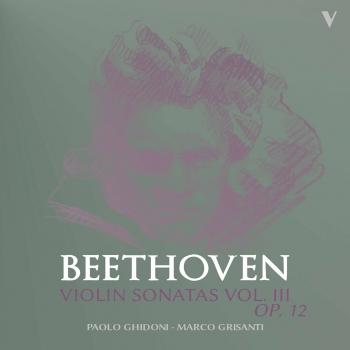
Beethoven: Violin Sonatas, Vol. 4 – Op. 96 & 24 Paolo Ghidoni & Marco Grisanti
Album Info
Album Veröffentlichung:
2019
HRA-Veröffentlichung:
13.12.2019
Label: OnClassical
Genre: Classical
Subgenre: Instrumental
Interpret: Paolo Ghidoni & Marco Grisanti
Komponist: Ludwig van Beethoven (1770–1827)
Das Album enthält Albumcover
- Ludwig van Beethoven (1770 - 1827): Violin Sonata No. 10 in G Major, Op. 96 "Cock-Crow":
- 1 Violin Sonata No. 10 in G Major, Op. 96 "Cock-Crow": I. Allegro moderato 11:13
- 2 Violin Sonata No. 10 in G Major, Op. 96 "Cock-Crow": II. Adagio espressivo 06:58
- 3 Violin Sonata No. 10 in G Major, Op. 96 "Cock-Crow": III. Scherzo. Allegro 02:04
- 4 Violin Sonata No. 10 in G Major, Op. 96 "Cock-Crow": IV. Poco allegretto 09:47
- Violin Sonata No. 5 in F Major, Op. 24 "Spring":
- 5 Violin Sonata No. 5 in F Major, Op. 24 "Spring": I. Allegro 10:10
- 6 Violin Sonata No. 5 in F Major, Op. 24 "Spring": II. Adagio molto espressivo 06:24
- 7 Violin Sonata No. 5 in F Major, Op. 24 "Spring": III. Scherzo. Allegro molto 01:18
- 8 Violin Sonata No. 5 in F Major, Op. 24 "Spring": IV. Rondo. Allegro ma non troppo 06:55
Info zu Beethoven: Violin Sonatas, Vol. 4 – Op. 96 & 24
The success of the Three Sonatas, Op. 12 convinced Beethoven that the genre was worth exploring further: within three years, he completed two other sonatas for piano and violin – Opp. 23 and 24. Originally intended to be published under the same opus number (23), a printing mishap forced the publisher to separate the two works.
Nicknamed posthumously as “Frühlingssonate” (Spring Sonata), the work is the first in the genre to be in four movements. It was dedicated to Count Moritz von Fries, a patron who was also the dedicatee of other works that Beethoven published around the same time. It is perhaps Beethoven’s most popular violin sonata.
By 1803, four more sonatas for piano and violin appeared in print – Opp. 30 and 47. Beethoven seemed to have found a congenial genre, especially in the highly virtuosic “Kreutzer” Sonata, Op. 47. However, it took him nine years to return to the genre. This time, he did so with a highly unconventional work – the Sonata in G Major, Op. 96. The French violinist Pierre Rode gave its premiere, alongside Archduke Rudolph at the piano. Beethoven wrote the final movement specifically with Rode in mind: the celebrated violinist apparently shunned virtuosic outbursts, which compelled the composer to give up the idea of a lively and technically challenging rondo, penning a set of variations on a jovial theme instead – an unusual choice for a closing movement.
Violinist Paolo Ghidoni and pianist Marco Grisanti team up in this exciting album, the third of the complete cycle of Beethoven’s sonatas for piano and violin.
The recording was made by the producer Alessandro Simonetto with two pair of historical microphones Brüel & Kjæer, including 130 volts.
Paolo Ghidoni, violin
Marco Grisanti, piano
Paolo Ghidoni
What can I say about Paolo Ghidon, or “Ghidon” for his friends – a nickname that has always felt a bit too tight for me, maybe because it makes me think of Kremer, who (despite I acknowledge his cunning) is not exactly my musical paragon?
When I was 8, my father put a violin under my chin, but at the beginning I couldn’t care less. Then, when I turned 10, a miracle happened. From that moment on, I started to yield vibrating sounds that would keep me tied to that chunk of wood. I spent hours and hours playing and listening to violin and, largely, orchestra records. Before I reached the age of 18, I graduated as external candidate the Music Academy with a cool 10, without honourable mention or overwhelming agreement, because some teachers didn’t like me at all and forced me to drop out beforehand.
Later, I obtained a run of accolades, culminating with the “Vittorio Gui” international chamber music prize at 19, with Norbert Brainin, first violin of “Quartetto Amadeus”, moved to tears.
Those were years of amazing concerts! With the “Trio Matisse” I played everywhere, and gradually chamber music creeped into me.
And then: a chair at the Conservatory, a solo and duo career with brilliant pianists such as Bruno Canino and Pier Narciso Masi, followed by a period as first violin with the “Virtuosi Italiani”, that gave me the thrill of conducting a string orchestra.
I can’t help mentioning Franco Gulli, at the “Accademia Chigiana”in Siena, the teacher I still remember fondly, a gentleman of bygone times and an extraordinary violinist.
But I can’t neglect my encounter with gifted Ivry Gitlis, and many more…
Hoping not to bore you, that “many more” includes collaborations with distinguished colleagues, beginning from Dino Asciolla, whom I can hardly define as a colleague, since he was–and still is – a myth of my youth.
But the fateful encounter, that I could define a brief and magical journey, was with Sviatoslav Richter. He was in Mantua in 1986 to record for Decca, and my father was a member of the club that had arranged this event.
So one morning I showed up before he arrived on the stage of Teatro Bibiena and I offered him a performance of Bach’s Chaconne. He listened to me intently and gave me some pieces of advice that still represent my “Pillars of Hercules”, for instance that the rhythmic continuity of the opening bars must keep going and also resonate in the following variations.
I remember I had his and David Oistrakh’s “Melodiya” record with me where they played Franck and Brahms’ Symphony No. 3 (I had listened to it a thousand times and it was already damaged), and I told him I loved it. He shook his head and suddenly sat at the piano and started to play the sonata, inviting me, with a “prego” in Italian, to play along. I still can’t understand how I managed to play, but I remember I thanked him with a slight bow and I ran away to cry my eyes out. That was one of the rare occasions I saw my father moved.
In my career I worked with Mario Brunello, Giuliano Carmignola, Danilo Rossi, Ifor James, Franco Maggio Ormezowski, Bruno Canino, Pier Narciso Masi (somehow he evokes Richter’s sound), but the magical encounter of that day in Mantua remains one of the most exciting and prodigious moments in my life.
Now, at 54, I have given about one thousand concerts in trio, as solo and first violin with an orchestra (I think of Pelé and his 1000 goals), still I don’t feel sated with it, not for vainglory, but because I could never live or love without music… I love it too much, and when I listen to Bach, when I play Schumann, I feel alive. Go figure!
Dieses Album enthält kein Booklet













